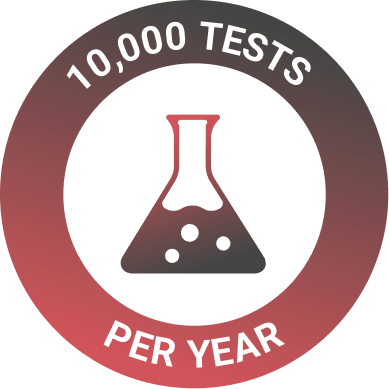The gel-clot technique
Home >> Gel-Clot Technique
The Gel-Clot technique
USP 85 outlines The gel-clot technique and Photometric Quantitative Techniques to
detect or quantify endotoxins. This method is based on the clotting response of Limulus amebocyte lysate (LAL) in the presence of endotoxins.
However, to ensure the efficacy and validity of the test, preparatory testing is done to demonstrate Labeled Lysate Sensitivity and Interfering factors.
Preparatory testing
Test for Labeled Lysate Sensitivity
- Test is performed in 4 replicates. In each of these replicates, the labeled sensitivity, expressed, λ, in EU/mL.
- Standard solutions of four concentrations ( 2 λ, λ, 0.5 λ, and 0.25 λ) are prepared by diluting the USP Endotoxin RS with Water for BET.
- Equal volumes of Standard Endotoxin Solutions ( 0.1 mL aliquots) from each test tube are mixed with Lysate TS.
- Reaction mixture is incubated at 37 ± 1°C for 60 ± 2 min or as per manufacturer’s recommendation, avoiding vibration.
- To check the integrity of gel, individually remove each tube from the incubator and invert it 180 degrees in a single fluid motion.
- If gel remains intact upon inversion, test results are considered as positive. On the other hand, the results are negative if intact gel is not formed. The test is valid when the lowest concentration of the standard solutions displays a negative result in all replicate tests.
- The endpoint refers to the lowest concentration among the descending series of standard endotoxin concentrations that causes the lysate to clot.
- Geometric mean endpoint is measured by calculating the average value of logarithm of the endpoint concentrations of the four replicate series.
Acceptance criteria – The geometric mean endpoint concentration determines the lysate sensitivity.
Test for Interfering factors
- Solutions (A–D) are prepared as detailed in Table 1, and an inhibition/enhancement test is conducted on the sample solutions at a dilution below the Maximum Valid Dilution (MVD), ensuring they do not contain any detectable endotoxins. This is conducted according to the method as described for the test for Confirmation of Labeled Lysate Sensitivity.
- The geometric mean endpoint concentrations for solutions B and C are calculated using the formula outlined in the procedure for the Test for Confirmation of Labeled Lysate Sensitivity.
Table 1. Solution preparation for the inhibition/enhancement test
Solution | Endotoxin Concentration/ Solution to Which Endotoxin Is Added | Diluent | Dilution factor | Endotoxin Concentration | Number of Replicates |
Aa | None/Sample Solution | — | — | — | 4 |
Bb | 2λ/Sample Solution | Sample solution | 1 | 2λ | 4 |
2 | 1λ | 4 | |||
4 | 0.5λ | 4 | |||
8 | 0.25λ | 4 | |||
Cc | 2λ/Water for BET | Water for BET | 1 | 2λ | 2 |
2 | 1λ | 2 | |||
4 | 0.5λ | 2 | |||
8 | 0.25λ | 2 | |||
Dd | None/Water for BET | — | — | — | 2 |
Acceptance criteria
- The test is considered valid if all replicates of Solutions A and D exhibit no reaction, and the results obtained from Solution C confirm the sensitivity as labeled.
- If the sensitivity of the lysate, when tested with Solution B, falls between 0.5 and 2, it suggests that the sample solution does not contain interfering substances under the experimental conditions applied.
Gel Clot Limit Test
Solutions (A-D) are prepared as indicated in table 2. Then, test is conducted on these solutions, by following the procedure outlined for Confirmation of Labeled Lysate Sensitivity.
Table 2. Solutions preparation for the Gel-Clot Limit Test
Solution* | Endotoxin Concentration/ Solution to Which Endotoxin Is Added | Number of Replicates |
A | None/Diluted Sample Solution | 2 |
B | 2λ/Diluted Sample Solution | 2 |
C | 2λ/Water for BET | 2 |
D | None/Water for BET | 2 |
Acceptance criteria
For the test to be considered valid, both replicates of Solutions B and C should have positive results, while results of both replicates of Solution D should be negative. If both replicates of Solution A yield negative results, it indicates that the tested preparation meets the requirements of the test. Whereas, if both replicates of Solution A give positive results, it indicates that the tested preparation does not comply with the test.
Quantitative assay
The testing procedure is used to measure the amount of bacterial endotoxins in sample solutions through a titration process to endpoint. Solutions (A-D) are prepared according to the specifications in Table 3, and the test on these solutions is carried out by adhering to the steps described in the preparatory testing/test for confirmation of labeled lysate sensitivity section.
Table 3. Solutions preparation for the Gel-Clot Assay
Solution | Endotoxin Concentration/ Solution to Which Endotoxin Is Added | Diluent | Dilution factor | Endotoxin Concentration | Number of Replicates |
Aa | None/Sample Solution | Water for BET | 1 | — | 2 |
2 | — | 2 | |||
4 | — | 2 | |||
8 | — | 2 | |||
Bb | 2λ/Sample Solution | — | 1 | 2λ | 2 |
Cc | 2λ/Water for BET | Water for BET | 1 | 2λ | 2 |
2 | 1λ | 2 | |||
4 | 0.5λ | 2 | |||
8 | 0.25λ | 2 | |||
Dd | None/Water for BET | — | — | — | 2 |
Acceptance criteria
The test is considered if it meets following requirements –
- If both replicates of negative control solution D are negative
- If both replicates of positive product control solution B are positive
- The geometric mean endpoint concentration of solution C ranges between 0.5 to 2
USP 85 outlines the gel-clot technique as a crucial method for assessing endotoxin levels in pharmaceutical products. At MIS, we specialize in providing USP 85 testing services specifically designed to meet the requirements of the pharmaceutical and medical industries.
To know more about our USP 85 testing services, talk to our experts here.



FAQs
USP 85 provides methods for the detection and quantification of endotoxin contamination in pharmaceutical products, medical devices, and similar materials. In USP 85, product samples are screened for endotoxins by using Limulus Amebocyte Lysate (LAL) test. LAL test can be performed using three techniques: Gel-clot, Turbidimetric, and Chromogenic Standard Endotoxin Stock Solution.
USP 85 test can be carried out for biologics, medical devices, injectable medications, ophthalmic products and intravenous solutions etc.
USP 85 test 3-4 weeks to complete.
Contact us for more information
Explore Other Tests
ASTME2149 | AATCC-100 | JISZ2801 | JISL1902 | EN 1276 | ISO 22196 | ISO 20743 | ISO 846 | ASTM E2180 | AATCC 147 | ASTM D7907-14 | ASTM E3031 | ASTM G29 | EN 16615 | EN 13697 | PAS 2424 | EN 1040 | EN 14349 | EN 13727 | EN 14561 | ASTM G22 | ASTM E1153 | ASTM D2574 | AATCC 174 | EN 14563 | EN 13704 | EN 1499 | EN 1500 | EN 14347 | EN 14348 | EN 1656 | EN 16437 | EN 12791 | ASTM E1174 | ASTM E2362
AATCC 30 | ASTM G21 | EN 1650 | EN 1657 | EN 13624 | EN 1275 | ASTM C1338 | ASTM D5590



